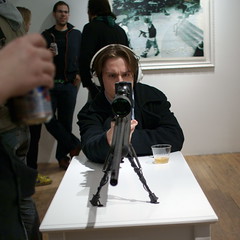
Above: A gallery patron interacts with "LAN Party" in the foreground; "Nothing Much Happened Today" on gallery wall in the background.
"Nowheresville," January 25 - March 8, 2008, damned Utopian idealism, having presented the audience with an opportunity to partake in an artist-coded "first-person shooter" video game, the action of which evoked a dystopian future upon multiple screens within the gallery space.[1] "Translation," September 11 - October 17, 2009, suggested a consideration of the progressive degrees of abstraction which were incidental to successive editions, wherein the opposing aim of generational fidelity was commonly understood to be primary.[2] Too, Springfield, Hybinette and Richards, while laboring in the service of conceptual ends, were attentive to their means.
In "Bad Boys," April 9 - June 5, 2010, Mason's epistemological concern with the idea of masculinity was focused upon the mediating device of the "screen" particularly, as the application of said corporate/institutional technology routinely forced a singular perspective and distance, shaping its user's interpretation of the world.[3]
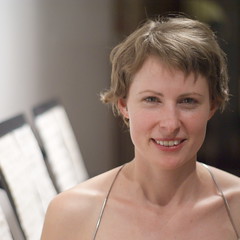
Above: Artist Noelle Mason.
How did such selective broadcast and monitoring--through the computer, through the scope, through the television, through the camera--affect the consciousness of the (chiefly male) viewers and subjects? "Not for the better," Mason answered in the sum of her artwork. And she was especially critical of said technology's application within the context of the criminal justice system and the military. There was the rub: How did one reconcile Mason's profoundly negative "take" on the issue with her long devotion to it?
To the extent that Chicago's art press, advocates, and other involved parties publicly commented upon the exhibition: the murder, Sadomasochism, and fascism hinted at therein tended to be lumped together under the umbrella term of "shock art." While it was good to see the engagement, and the reviews were generally fine,[4-7] Mason's artwork was not visually descriptive of horror; nor with regard to the nature of suffering was it truthful; rather, it was clean, cool, and nearly colorless.
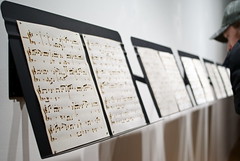
Above: "Sonata" and a gallery patron.
In fact, her artwork might have been read as a fetish for peculiar violence; among the pieces on display, a darkly sexual reference was overt in "Fond," and "Big Stick," at least. Though, as in the case of her tender recreation of Nazi obsession, psychological upset of the attentive and sensitive viewer was most likely caused by her queer choice to, quite literally, soften subjects which ought to have been intellectually, and emotionally, hard.
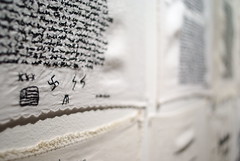
Above: "Love Letters" close-up, detail.
Having written all of that, as much as Mason might have evinced an interest in the "at risk," young, male population of contemporary America, and as much as Mason's work might also have been autobiographical, her study (following Springfield, Hybinette and Richards) of the screen's distortion of *the idea* is increasingly relevant to Chicago's so-called art community, wherein one is tempted to believe that the "experience" of art is ever more often vicarious.
+ + +
Counterpoint: Nicholas Knight is something of a globe-trotting museum aficionado. And, for four of the past five years, his attention has been equally divided between his fellow visitors and the objects on display. Knight has watched men and women, of various ages, races, and cultural backgrounds, assume the same position before works which pique their interest: arm raised, cellphone camera extended, eyes focused upon the image contained in the screen therein.
It's at that moment when he photographs them.
While appreciative of the irony of the situation, Knight doesn't seem to be upset by, or disdainful of, the screen-based perception of such patrons. Considering the available light, laboring to frame the composition, picture-takers inevitably have a truly visual experience--bringing them closer to the "mind" of the original author, i.e., the artist.
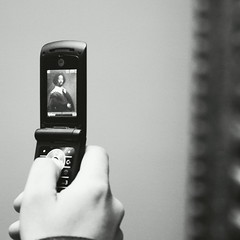
Knight's photography is currently on display at Bill Gross' 65Grand gallery. The scale of the prints is in some cases maybe too ambitious; regardless, the concept is clear and strong.
+ + +
[1] "Nowheresville," Knut Hybinette & Troy Richards,
http://www.thomasrobertello.com/exhibition/view/912
[2] "Translation," Molly Springfield,
http://www.thomasrobertello.com/exhibition/view/1616
[3] "Bad Boys," Noelle Mason,
http://www.thomasrobertello.com/exhibition/view/1716
[4] Candice Weber, Time Out Chicago,
http://chicago.timeout.com/articles/art-design/85053/noelle-mason-at-thomas-robertello-art-review
[5] Ian Epstein, Newcity,
http://art.newcity.com/2010/04/12/portrait-of-the-artist-noelle-mason/
[6] Jeffery McNary, Neoteric Art,
http://neotericart.com/2010/04/12/art-review-%E2%80%94-noelle-mason-bad-boys-by-jeffery-mcnary/
[7] Britt Julious, ARTWRIT,
http://artwrit.com/VOL3/04.html
Thomas Robertello Gallery
Wednesday through Saturday 12 - 5
939 West Randolph Street
Chicago, IL 60607
312.421.1587
Noelle Mason,
http://noellemason.com
+ + +
Nicholas Knight
"Declaimed"
January 14 - February 12, 2011
Friday and Saturday, 12:00pm-5:30pm
(and by appointment)
65GRAND
1369 W. Grand Ave.
(312) 719-4325
http://www.65grand.com
Nicholas Knight,
http://nicholasknight.net
See also: “To Shoot or not to Shoot” by Vicki Schneider,
http://neotericart.com/2010/12/30/to-shoot-or-not-to-shoot-by-vicki-schneider/
- Paul Germanos
No comments:
Post a Comment